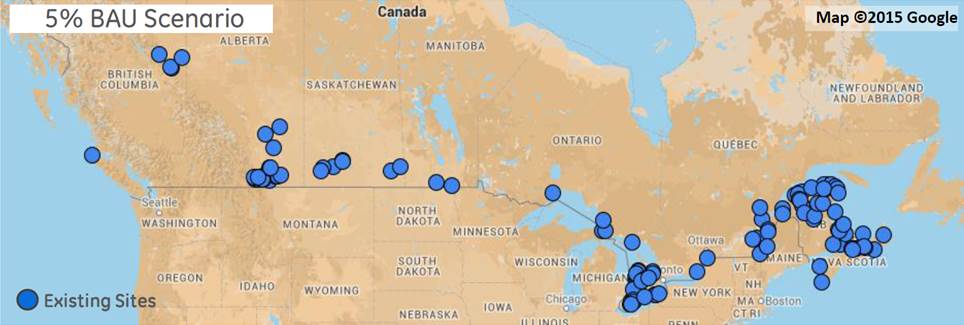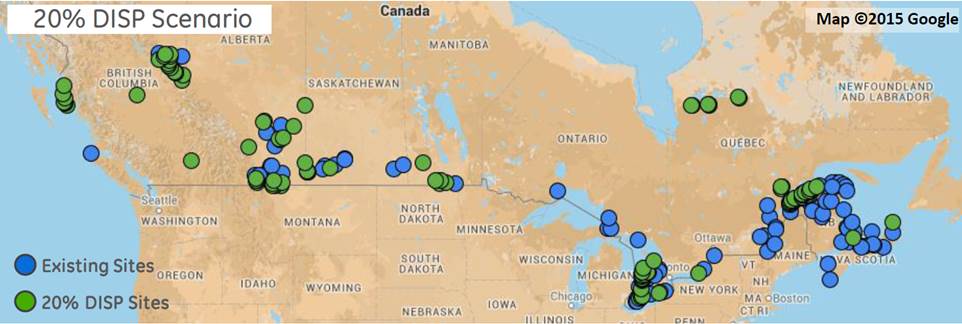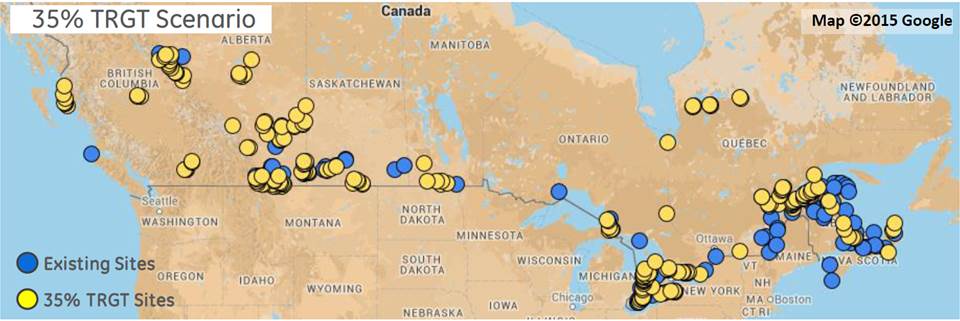Lead Proponent: Canadian Wind Energy Association
Location: Ottawa, Ontario
ecoEII Contribution: $1,755,000
Project Total: $ 2,756,963
Project Background:
As of 2015, wind energy satisfies approximately 5% of Canada’s electricity demand, with large variability across the provinces and territories. This is a modest level of penetration given the world-class quality of Canada’s wind resources. One of the major hurdles preventing wind from playing a more significant role has been the lack of scientific information on the actual amount of wind energy that could be reliably and economically injected into Canada’s electricity grid.
Wind integration studies previously conducted for selected provinces provided only partial and incomplete answers. Indeed, the Canada-U.S. electrical grid is a highly integrated and complex system. As such, partial integration studies cannot grasp the challenges and opportunities in their entirety. Recognizing the need, the Canadian Wind Energy Association (CanWEA) conceived a nation-wide wind integration study and proposed the project "Pan-Canadian Wind Integration Study (PCWIS)" for ecoEII funding. The Project was awarded $1.755M to identify the challenges, opportunities, as well as mitigation measures and operational tools needed to efficiently integrate large amounts of wind energy into Canada’s electrical system.
Results
Through a competitive process, CanWEA selected a consortium led by GE’s Energy Consulting business to conduct the study. GE provided overall project leadership, production cost simulation and reliability analysis. Other key members included Vaisala, EnerNex, Electranix, and Knight Piésold as the project team, DNV GL as a consultant to CanWEA and a Technical Advisory Committee that included Canadian and U.S. regulators who provided support and guidance.
The PCWIS modelled power grids in Canada and most of the United States (U.S.) under four scenarios, with wind penetration at 5% to 35% of the forecasted annual system electrical energy production in 2025. The scenarios were: Business As Usual (BAU) with 5% wind, Dispersed Wind Locations (DISP) with 20% wind by province, Concentrated Wind Locations (CONC) with 20% wind by best resources, and Targeted Wind Locations (TRGT) with 35% wind penetration. At the start, over 54,000 potential "cells" were identified, where each cell represented a hypothetical 2x2 km wind development site collocated with a numerical weather prediction grid point, and a presumed maximum installation capacity of 8x2 MW wind turbines. Cells were then combined into utility-scale wind power plants to achieve the penetration levels of each scenario, and additional firm capacity was included to meet reserve margin targets of each province. Finally, sufficient transmission expansion was embedded to allow import and export to neighboring provinces and the United States. Hourly dispatch simulation and sub-hourly statistical analysis were performed for the year 2025, using wind generation and load profiles over 3 calendar years to assess the impact of the wind energy on grid economics and operations for each scenario. Sensitivity analysis was performed to assess the influence of parameters such as: price of natural gas, extent of coal retirement, variability of wind resources, and addition of storage and variable loads.

5 per cent BAU (Business As Usual) Scenario
Text Version
The business as usual scenario includes existing wind plants and those under construction as of April 2015.

20 per cent DISP (Dispersed Wind Penetration) Scenario
Text version
The dispersed scenario includes the BAU scenario sites plus additional sites deemed best to achieve 20 per cent penetration within each province.

20 per cent CONC (Concentrated Wind Penetration) Scenario
Text Version
The concentrated scenario achieves 20 per cent penetration nationally (not in each province) via BAU sites plus those with the highest capacity factor wind resources.

35 per cent TRGT (Targeted Wind Penetration) Scenario
Text version
The targeted scenario builds on the dispersed scenario plus targets (within limits) provinces with high thermal generation to achieve 35 per cent penetration nationally.
The PCWIS concludes that the Canadian electrical grid can accommodate large amounts of wind energy reliably and economically. In fact, with adequate transmission reinforcements and additional regulating reserves, the system should not experience any significant operational issues with 20% or 35% of its load demand met by wind. In the TRGT 35% wind scenario, up to 32 million tons of CO2 emissions could be avoided annually and $47/MWh of production costs could be saved (when compared to BAU 5% wind). Furthermore, study results indicate that Canada has high quality wind resources in all provinces (sites considered in the PCWIS had capacity factors above 36%), and that there is no significant advantage to concentrating wind generation in provinces with higher wind capacity factors. Instead, it is more beneficial to add the wind generation where the energy can be partially used within the region and/or shared with the U.S.
Benefits to Canada
The underlying study model presents a national view of the electrical system that had not previously existed, and provides Canadian wind integration data of a nature, type and extent that had never been available before, thereby making it possible for Canada to participate in future continent-wide North American studies. Study data may also be used to inform the development of energy policies throughout Canada (and neighbouring U.S.).
Next Steps
CanWEA intends to facilitate the use of PCWIS in an upcoming continental integration study and ensure public access to the full PCWIS database.